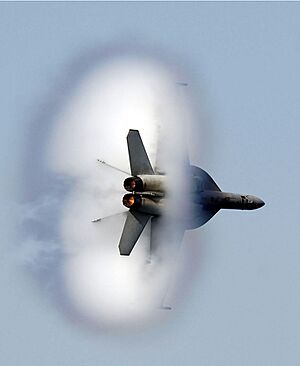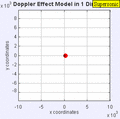Sonic boom facts for kids

A sonic boom is a loud, explosive sound. It happens when an object moves faster than the speed of sound. Imagine an airplane flying so fast that it leaves its own sound behind! This creates a powerful shock wave that we hear as a "boom."
People often call this "breaking the sound barrier." The visible part you sometimes see with a sonic boom is actually air. This air gets squashed and pushed together by the strong sound waves. Even thunder is a type of sonic boom! It's caused by lightning heating the air so fast that it expands quicker than the speed of sound.
Contents
What is a Sonic Boom?
A sonic boom is a sudden, loud noise. It sounds like an explosion or a clap of thunder. This sound is made by objects that travel faster than the speed of sound. Airplanes, space shuttles, and even whips can create sonic booms.
How Does a Sonic Boom Happen?
When an object moves, it creates sound waves. If the object moves slower than sound, these waves spread out in front of it. But if the object moves faster, it catches up to its own sound waves.
These sound waves then pile up, forming a powerful shock wave. Think of it like a boat moving through water. If it goes fast enough, it creates a V-shaped wave behind it. A sonic boom is similar, but it happens in the air with sound waves.
The Speed of Sound
The speed of sound changes depending on the air. At sea level, sound travels about 767 miles per hour (1,235 kilometers per hour). This speed is also called Mach 1. When an object reaches Mach 1, it "breaks the sound barrier."
Visible Effects
Sometimes, you can see a cloud or a cone shape around an aircraft making a sonic boom. This isn't the sound itself. It's water vapor in the air that suddenly cools down due to the pressure changes from the shock wave. This makes a temporary cloud.
Who First Broke the Sound Barrier?
The first person to fly an airplane faster than the speed of sound was Chuck Yeager. He did this on October 14, 1947. Yeager was flying a special plane called the Bell X-1. This was a huge step forward in aviation history!
Images for kids
-
New research is being performed at NASA's Glenn Research Center that could help alleviate the sonic boom produced by supersonic aircraft. Testing was completed in 2010 of a Large-Scale Low-Boom supersonic inlet model with micro-array flow control. A NASA aerospace engineer is pictured here in a wind tunnel with the Large-Scale Low-Boom supersonic inlet model.
-
A point source emitting spherical fronts while increasing its velocity linearly with time. For short times the Doppler effect is visible. When v = c, the sonic boom is visible. When v > c, the Mach cone is visible.
See also
 In Spanish: Explosión sónica para niños
In Spanish: Explosión sónica para niños









